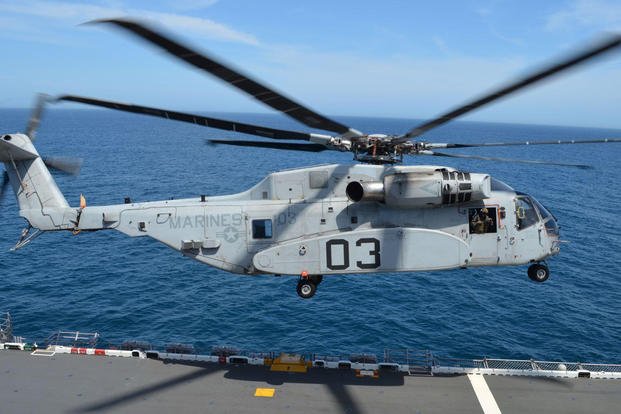The Marine Corps' new heavy-lift helicopter, intended to play a vital role in the service's plans for sea-based operations in the Pacific, just wrapped up its sea trials and will tackle hot-weather training next.
The CH-53K King Stallion heavy-lift helicopter reached a new milestone this month after spending two weeks aboard the amphibious assault ship Wasp. The sea trials marked the first time the aircraft was put to the test in a real-world naval environment.
The aircraft took off and landed more than 360 times in daylight and darkness as officials worked to mimic deployment conditions. Tests included launch and recovery, rotor start and shutdown, blade fold and shipboard compatibility testing, Naval Air Systems Command officials said after the trials were completed.
Read Next: Sen. Warren: Revoke Medals of Honor Awarded to Troops in 'Wounded Knee' Massacre
Data from the tests are still being analyzed, said Megan Wasel, a spokeswoman for the Navy Department's Air Anti-Submarine Warfare, Assault and Special Mission Programs.
"But so far we see no big technical issues," she said of the CH-53K, which is set to replace the Marine Corps' aging CH-53E Super Stallion. The massive aircraft, which can carry nearly 14 tons for 110 nautical miles, is the Defense Department's most powerful helicopter.
The Marine Corps plans to buy 200 King Stallions, but the program has seen a series of setbacks due to mechanical and design problems that pushed back its expected initial operational capability from 2019 to 2021. The Marine Corps announced in December it had fixed an engine problem some were concerned would reduce the helicopter's power, but it's still not expected to deploy for several more years.
Bill Falk, director of Sikorsky's CH-53K program, said the King Stallion's "exceptional performance" during the sea trials brought the aircraft one step closer to its first deployment.
"The CH-53K is right at home aboard a large-deck amphibious ship," Falk said. "... [The aircraft] excelled in the shipboard environment, reinforcing its critical role allowing Marines the operational flexibility to move more material, more rapidly from ship to shore."
This summer, the CH-53K will go through hot weather and degraded visual environment testing, Wasel said. Degraded visual environment training could include fog, dust and other scenarios that affect air crews' visibility.
The aircraft's GAU-21 window and ramp machine guns will also soon undergo testing, the fire extinguishing system will undergo qualification, and aerial refueling tests with the KC-130 will continue, Wasel said.
The King Stallion is expected to be deployed to the fleet between 2023 and 2024, she added.
-- Gina Harkins can be reached at gina.harkins@military.com. Follow her on Twitter @ginaaharkins.
Related: Marines Say They've Fixed Engine Troubles on New King Stallion












